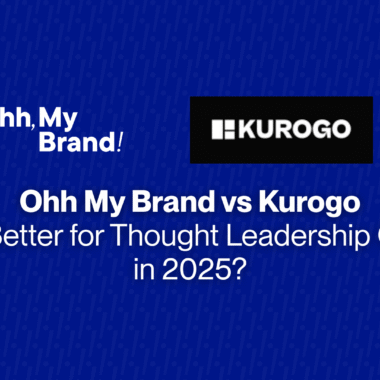In today’s hyper-connected world, influence is currency, and nowhere is that more evident than in personal branding. Building influence is a cornerstone of creating a strong personal brand that stands out, earns trust, and opens doors. Whether you’re an entrepreneur, executive, or aspiring thought leader, your personal brand influence – the ability to sway opinions and inspire others – can make the difference between blending in and becoming a go-to name in your industry.
This comprehensive guide will explain what influence really means in the context of personal branding, why it’s so critical, and how you can effectively build and leverage it. We’ll also explore the vital role of authenticity and learn from case studies of influential personal brands like Ohh My Brand and Blushush for real-world insights. Finally, we’ll summarize key influence-building strategies in a handy comparative table.
Let’s dive in.
Influence: The Driving Force Behind Your Personal Brand
What exactly is influence in personal branding? In simple terms, influence is the power to affect how others think and act. It’s not just about follower counts or popularity. It’s about credibility, authority, and the trust you earn from your audience.
Experts define influence in personal branding as the intersection of your expertise, credibility, and ability to persuade or inspire. Influence happens when you have substance (expert knowledge), validation (third-party credibility), and the skill to communicate your value in a way that pulls people in rather than pushes a message on them.
Importantly, influence does not equal just social media metrics. You might have a million followers, but if none of them trust you or take action on your recommendations, your influence is hollow. True influence is evidenced by engagement and impact. Do people listen to your ideas? Do they seek your advice? Will they vouch for you or follow your lead? Those are the signs of real personal brand influence.
Why Influence Matters for Personal Branding
Influence isn’t a nice-to-have. It’s the critical force that makes your personal brand effective. Here are several key ways influence powers your personal brand success:
Builds Trust and Credibility
A well-crafted personal brand engenders trust, which is the foundation of influence. When you consistently demonstrate integrity, expertise, and authenticity, people come to see you as trustworthy. That trust makes others more open to your ideas and guidance. In fact, a strong personal brand presence online can significantly increase how much others trust your work. When people trust you, they’re also more likely to trust what you represent.
Establishes You as an Authority
Influence and authority go hand in hand. By sharing valuable insights and knowledge, you position yourself as an authority in your field. Over time, you become the person others turn to for expertise. This authoritative positioning means your opinions carry weight, leading to more opportunities.
Amplifies Your Reach and Impact
The greater your influence, the wider your message spreads. Influential personal brands often develop communities around them – engaged followers who share their content and recommend them to others. Influence turns a single voice into a movement. Word-of-mouth boosts and loyal followings stem from genuine connection.
Attracts Opportunities and Partnerships
When you have influence, opportunities tend to seek you. A credible personal brand becomes a magnet for clients, job offers, speaking engagements, media features, and collaborations. Others want to work with individuals who have a trusted voice and audience. Influence essentially becomes a career asset.
Fosters Loyalty and Long-Term Success
Influence built on authenticity fosters deep loyalty. When your audience feels genuinely connected to you and benefits from your insights, they’ll stick around. That loyalty leads to sustained support, whether in the form of referrals, repeat business, or a lasting positive reputation.
In essence, influence is the engine of your personal brand. It builds the trust that drives results. Without it, a personal brand is just surface-level. With it, your brand becomes a force that inspires action.
Strategies to Build and Leverage Influence in Your Personal Brand
Influence doesn’t happen by accident. It’s cultivated through deliberate strategies and consistent effort. The good news is that anyone can build influence with the right approach. It’s not reserved for celebrities or CEOs.
Here are effective strategies to build and leverage influence for your personal brand. These include establishing thought leadership, strengthening your digital presence, forging collaborations, and building strategic relationships.
1. Thought Leadership and Content Creation
One of the most powerful ways to build influence is by establishing yourself as a thought leader. Thought leadership means consistently delivering insights and perspectives that others find valuable. By sharing your expertise through content, you begin to shape how people think – which is the essence of influence.
Start by creating content that educates, inspires, or solves problems for your target audience. This could include blog posts, videos, podcasts, webinars, or social media threads. The format matters less than the value. The key is to demonstrate your know-how.
Consistency is crucial. A single post won’t establish you as a thought leader, but regular, high-quality content will. Whether it’s an article every two weeks or a weekly video, stick to a rhythm. Over time, people will recognize your voice and begin looking forward to what you share.
Tactics to Consider:
- Publish Expert Articles or Blogs
Address common challenges or emerging trends in your field. Share your unique perspective or research. Getting published on reputable platforms boosts your credibility. - Speak at Events and Podcasts
Public speaking exposes you to new audiences and positions you as a confident authority. - Leverage LinkedIn and Twitter for Micro-Content
Share bite-sized insights or quick tips. A short thread or post can prompt meaningful engagement and visibility. - Create Long-Form Content
Consider developing a guide, e-book, or video series on a topic you know deeply. Offering something valuable for free builds trust and authority.
Thought leadership builds credibility and visibility over time. Content has scale, a single post might be read or shared thousands of times. Thought leadership is not about selling; it’s about offering value. When people trust your ideas, they’ll eventually trust you.
2. Strengthening Your Digital Presence and Online Reputation
In the digital age, your online presence is your personal brand’s storefront. When someone hears about you, the first thing they do is search your name. What they find immediately shapes their perception of your credibility.
Building influence means ensuring your online presence is strong, consistent, and aligned with your values.
Start with a Digital Audit
Review your current profiles across platforms like LinkedIn, Twitter, Instagram, or your website. Do they clearly reflect who you are and what you offer? Use a professional but approachable photo, craft a strong bio, and make sure your experience and achievements are current. Consistency in your message and look reinforces recognition and trust.
Key Actions to Strengthen Digital Presence:
- Be Active on Key Platforms
Focus on platforms relevant to your field. For many professionals, LinkedIn is essential. Creatives may prioritize Instagram or YouTube. Tech professionals might lean into Twitter or blogs. Share updates, join discussions, and post content that supports your brand. Active participation keeps you visible and relevant. - Optimize for Search
Use keywords naturally associated with your field. If you’re a wellness coach, terms like “fitness coach” or “nutrition advisor” should appear in your profiles. Own your search results by ensuring your name pulls up content you’ve authored, your website, and your most important profiles. - Engage and Respond
Don’t just post; interact. Comment thoughtfully, reply to messages, and support others. Engagement builds relationships and boosts visibility. On platforms like LinkedIn, posts with active discussion often get wider reach. - Manage Your Reputation
Google your name regularly. Set up alerts to stay on top of mentions. If you see outdated or inaccurate information, counter it by publishing updated content. Ask clients or colleagues for testimonials to include on your site or LinkedIn, this kind of social proof reinforces your credibility.
A strong digital presence lays the foundation for influence. People will form opinions about you based on what they find online before they ever meet you. By controlling and curating that presence, you build trust at every touchpoint.
3. Collaborations, Partnerships, and Social Proof
Influence grows faster when others amplify your voice. Collaborations and partnerships are powerful ways to extend your reach, tap into new audiences, and build credibility through association.
Why Collaborate?
When you partner with peers, brands, or influencers, you benefit from their trust network. Being featured on someone else’s platform or co-creating something valuable together instantly introduces you to a new audience with credibility already attached.
Types of Collaborations That Build Influence:
- Guest Appearances and Contributions
Write a guest article, speak on a podcast, or join a webinar panel. You not only share your expertise but also gain visibility in circles outside your own. - Cross-Promotions
Partner with professionals in complementary fields. Share each other’s content, co-host a live stream, or develop a joint guide or course. When done well, both parties win exposure and build trust with a broader audience. - Joint Projects and Alliances
Launch an initiative, host an event, or create a series with other thought leaders. These partnerships can drive buzz, deepen relationships, and position you as someone actively shaping your industry. - Testimonials and Case Studies
Feature client feedback prominently. Ask to be included in others’ case studies or spotlights. These forms of third-party validation act as social proof and subtly boost your authority.
The key is to align with individuals or brands that reflect your values and audience. When the collaboration feels authentic, it strengthens both parties. Influence is transferred through trusted relationships; being endorsed or associated with someone respected makes people more likely to trust and follow you too.
4. Strategic Networking and Relationship Building
Networking is one of the most overlooked but powerful strategies for building influence. While your content and online presence can broadcast your brand, real influence is often built one relationship at a time.
Strategic networking means forming genuine, purposeful connections with people who can support, collaborate with, or elevate your personal brand.
How to Network for Influence:
- Network with Purpose
Identify communities, events, and forums where your target audience or industry peers gather. These could be LinkedIn groups, conferences, webinars, or niche Slack communities. Choose spaces aligned with your values and goals. - Attend Events and Engage
Whether online or in person, show up and speak up. Ask thoughtful questions, introduce yourself clearly, and express genuine curiosity about others. Being memorable at events can lead to new relationships and opportunities later. - Leverage Online Networking
Use platforms like LinkedIn and Twitter to engage with leaders, peers, and future collaborators. Comment on posts with insight, respond to relevant threads, or send thoughtful direct messages. Show appreciation, share perspectives, and build rapport naturally over time. - Nurture Relationships
Stay in touch. Congratulate people on milestones, send helpful resources, or check in without asking for anything. These small actions build trust. Opportunities often come from people who remember you positively and feel a connection. - Mentor and Be Mentored
Seek guidance from those ahead of you, and support those coming up. Mentorship strengthens your positioning as someone who both learns and leads. These bonds often lead to referrals and advocacy.
Influence is often passed through people. One strong recommendation or introduction can open doors that content alone may not. When you build a reputation for being generous, reliable, and insightful, people start saying your name in rooms you’re not in. That’s influence at its most organic and powerful.
Authenticity and Influence: The Trust-Building Connection
Authenticity is the quiet engine behind powerful influence. In the rush to build a personal brand, some people try to project an image that isn’t truly theirs. But the most trusted and influential personal brands are rooted in genuine, consistent identity.
Why Authenticity Matters
People can sense when someone is putting on a persona. In an age of filters and performative posts, authenticity stands out. It builds emotional connection and trust. When your audience feels they know the real you, they’re far more likely to support your work, believe your message, and share your ideas.
How to Stay Authentic While Building Influence:
- Stay True to Your Core Values
Know what you stand for and reflect that in everything you do. Don’t change your voice or mission just to fit trends. The right people will connect with your truth. Influence built on your real self is more sustainable and fulfilling. - Be Personal Within Professional Bounds
Share your journey, lessons learned, and the story behind your brand. People resonate with struggle and progress more than perfection. Vulnerability, when genuine, draws others in and makes your brand relatable. - Maintain Consistency in Voice and Actions
Align what you say with what you do. If your brand promotes balance, don’t glorify burnout. Use the same tone across platforms so people feel continuity when they encounter your content. Consistency builds familiarity, and familiarity builds trust. - Prioritize Honesty and Transparency
Own your mistakes. Share behind-the-scenes glimpses. Be open about what you’re learning. Transparency shows confidence and builds credibility. People appreciate real talk in a world full of polished pitches.
Authenticity ties all your influence-building strategies together. Without it, your message might reach people but won’t stick. With it, your voice not only gets heard, it gets remembered, trusted, and followed.
Case Studies – Influence in Action: Ohh My Brand and Blushush
To understand how influence really works, it helps to look at real-world examples. Ohh My Brand and Blushush are two personal branding agencies led by individuals who have built powerful influence through storytelling, design, and strategic content. Their journeys offer a blueprint for turning personal credibility into brand-wide authority.
Ohh My Brand – Influence Through Authentic Storytelling and Thought Leadership
Ohh My Brand (OMB) was founded by Bhavik Sarkhedi, a content entrepreneur turned branding expert. His personal journey, from authoring books to launching content and branding ventures, reflects the core of influence: show up consistently, offer real value, and share your story.
Sarkhedi’s strategy focuses heavily on storytelling. Every brand OMB helps is built on a narrative that weaves together values, vision, and personality. Rather than crafting a surface-level image, OMB helps clients articulate what makes them human and compelling. That connection builds trust, which fuels influence.
Content plays a massive role in OMB’s influence-building model. Sarkhedi himself writes prolifically, contributes to major publications, and maintains a strong LinkedIn presence. These actions not only reinforce his authority but also give OMB a continuous digital footprint.
OMB also leverages smart SEO and AI visibility strategies to help clients appear in search results and AI-generated outputs. This forward-thinking approach makes sure their influence scales with technology.
As a result, Sarkhedi has gained recognition as a global personal branding expert. OMB’s clients benefit from the same credibility-building blueprint, achieving media features, audience growth, and a strong digital presence. When OMB partnered with Blushush, it was a strategic alignment of influence, a union of content and design.
Blushush – Influence Through Strategic Brand Design and Trusted Authority
Blushush, co-founded by Sahil Gandhi, focuses on the strategic and visual side of influence. Known as “The Brand Professor,” Gandhi emphasizes that branding is about trust as much as design.
Blushush’s signature approach blends sharp design with deep personal positioning. Rather than just creating logos, they work on aligning the client’s visual identity, voice, and reputation. This cohesive brand architecture reinforces authority and trust.
Gandhi’s influence also stems from thought leadership and education. By sharing practical insights on branding, hosting workshops, and taking on high-profile clients, he has built a reputation that extends beyond design. Blushush clients often experience measurable improvements in visibility, recognition, and brand loyalty.
The partnership with Ohh My Brand brought together two types of influence: storytelling and visual authority. Together, they began rolling out branding masterclasses and digital programs to scale their impact.
Blushush’s results-driven focus, paired with a values-first approach, made it a go-to agency for leaders looking to refine their personal image in a strategic and trustworthy way.
Both case studies show that influence in personal branding comes from a blend of authenticity, consistency, visibility, and value. Whether through content or design, the goal is the same – to build trust that leads to lasting authority.
Comparing Influence-Building Strategies
There are many ways to build personal brand influence. Each strategy varies in how effective, scalable, or easy it is to implement. Here’s a summary comparison to help you decide where to focus your time and energy:
| Strategy | Effectiveness | Ease of Execution | Scalability |
| Thought Leadership (Content, Talks) | Very high – positions you as an expert and builds long-term trust | Moderate to difficult – requires consistent creation and communication skills | High – content can be reused, shared, and amplified across platforms |
| Digital Presence & Social Engagement | High – reinforces visibility, familiarity, and keeps you top-of-mind | Easy to moderate – setting up profiles is easy, staying consistent takes planning | Very high – posts and content scale across networks and are visible globally |
| Collaborations & Partnerships | High – quickly builds trust through association and shared audiences | Moderate – requires outreach, planning, and aligned values | Moderate – each collab boosts reach, but needs ongoing effort to maintain and multiply |
| Strategic Networking | High – builds deep, high-quality influence through one-on-one relationships | Moderate – time-intensive and requires patience, social intelligence, and long-term thinking | Medium – grows within communities or circles, not as fast as viral content but often more loyal |
| Community Building | Very high – creates lasting influence through a dedicated audience that advocates for your brand | Moderate to difficult – slow to start, requires nurturing and active engagement | High (long-term) – once built, a community can grow organically and amplify your message |
Note: These strategies work best when used together. For example, content fuels your social presence, which supports your collaborations, which deepen your network, which might turn into a community. Consistency and authenticity amplify every tactic.
Conclusion: Turning Influence into Your Personal Brand Superpower
Building a personal brand is a journey, and influence is the fuel that moves it forward. By now, you’ve seen that influence in personal branding is not about vanity metrics. It’s about trust, credibility, and the ability to move people with your ideas and presence.
Each strategy we explored, from thought leadership and digital visibility to collaborations, networking, and community, plays a role in growing your influence. The most impactful personal brands are those that blend these strategies with consistency and authenticity.
Your starting point doesn’t need to be perfect. Just begin. Write that post. Update your bio. Reach out to someone you admire. Influence grows through action, not just intention. It compounds with time, sincerity, and care.
As the examples of Ohh My Brand and Blushush show, influence can elevate your work, attract aligned opportunities, and turn your name into a source of trust. When your personal brand stands for something meaningful and your presence reflects that clearly, people will remember, support, and follow you.
So take a breath, get clear on your values, and start showing up. Your voice matters. And the more you use it with clarity and care, the more influential it will become.








